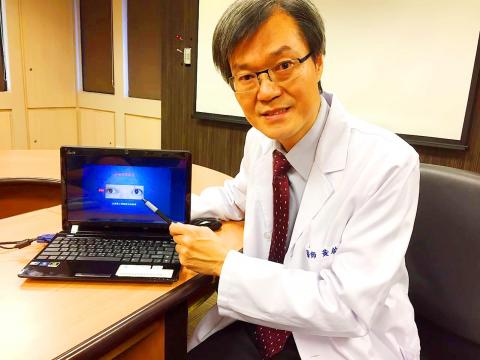People should visit a doctor immediately if they suddenly develop double vision or if they develop skew deviation, as such symptoms can be fatal if untreated.
Taipei Shu Tien Clinic doctor Huang Chi-hsun (黃啟訓) said the clinic had one case of double vision, also known as diplopia, and one of skew deviation, which were diagnosed as directly affecting the third, fourth and sixth cranial nerves.
The three pairs of nerves in the cranial nervous system coordinate eye movement, and damage to any one of the three can cause skew deviation, Huang said.

Photo: Chou Yan-yu, Taipei Times
The first case was the sudden development of diplopia in a 35-year-old patient surnamed Liu (劉), Huang said.
A computed tomography scan showed that the patient had sustained a brainstem aneurism, which was placing pressure on the patient’s third cranial nerve, Huang said.
The clinic performed surgery to remove the aneurism, Huang said, adding that had it not been removed, the patient could have sustained a cerebral hemorrhage.
An aneurysm occurs when part of an artery wall weakens, allowing it to widen abnormally or balloon out, which could be congenital or due to arteriosclerosis, which can occur with age or due to hyperglycemia, hypertension or hyperlipidemia, Huang said.
Liu’s vision returned to normal following the surgery, Huang added.
The second case involved a 79-year-old who had been diagnosed with diabetes, Huang said.
The patient visited the clinic after developing skew deviation and double vision, and had a glycated hemoglobin level of 8.2 — the standard for diabetics is 7, Huang said.
The patient was diagnosed with diabetic neuropathy, which damaged the fourth and sixth cranial nerves, Huang said, adding that the condition was due to improper blood sugar level control, which led to arteriosclerosis.
After medication and stricter blood sugar level control, the patient’s condition has stabilized, Huang said.
Patients with sudden development of skewed deviation or diplopia who are not in any pain should see a doctor to rule out the possibility of an aneurism, Huang said.
If not treated in time, aneurisms are fatal when they burst, Huang said, adding that diabetics should monitor their blood sugar levels.

Taiwanese scientists have engineered plants that can capture about 50 percent more carbon dioxide and produce more than twice as many seeds as unmodified plants, a breakthrough they hope could one day help mitigate global warming and grow more food staples such as rice. If applied to major food crops, the new system could cut carbon emissions and raise yields “without additional equipment or labor costs,” Academia Sinica researcher and lead author the study Lu Kuan-jen (呂冠箴) said. Academia Sinica president James Liao (廖俊智) said that as humans emit 9.6 billion tonnes of carbon dioxide compared with the 220 billion tonnes absorbed

The Taipei Mass Rapid Transit (MRT) Wanda-Zhonghe Line is 81.7 percent complete, with public opening targeted for the end of 2027, New Taipei City Mayor Hou You-yi (侯友宜) said today. Surrounding roads are to be open to the public by the end of next year, Hou said during an inspection of construction progress. The 9.5km line, featuring nine underground stations and one depot, is expected to connect Chiang Kai-shek Memorial Hall Station to Chukuang Station in New Taipei City’s Jhonghe District (中和). All 18 tunnels for the line are complete, while the main structures of the stations and depot are mostly finished, he

Taipei is to implement widespread road closures around Taipei 101 on Friday to make way for large crowds during the Double Ten National Day celebration, the Taipei Department of Transportation said. A four-minute fireworks display is to be launched from the skyscraper, along with a performance by 500 drones flying in formation above the nearby Nanshan A21 site, starting at 10pm. Vehicle restrictions would occur in phases, they said. From 5pm to 9pm, inner lanes of Songshou Road between Taipei City Hall and Taipei 101 are to be closed, with only the outer lanes remaining open. Between 9pm and 9:40pm, the section is

China’s plan to deploy a new hypersonic ballistic missile at a Chinese People’s Liberation Army Rocket Force (PLARF) base near Taiwan likely targets US airbases and ships in the western Pacific, but it would also present new threats to Taiwan, defense experts said. The New York Times — citing a US Department of Defense report from last year on China’s military power — on Monday reported in an article titled “The missiles threatening Taiwan” that China has stockpiled 3,500 missiles, 1.5 times more than four years earlier. Although it is unclear how many of those missiles were targeting Taiwan, the newspaper reported